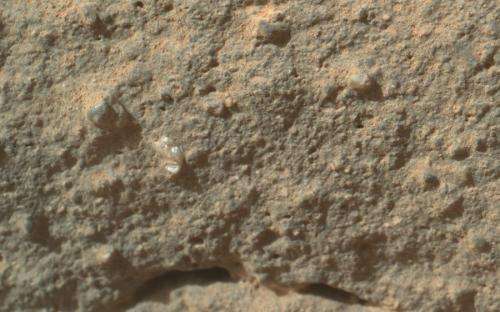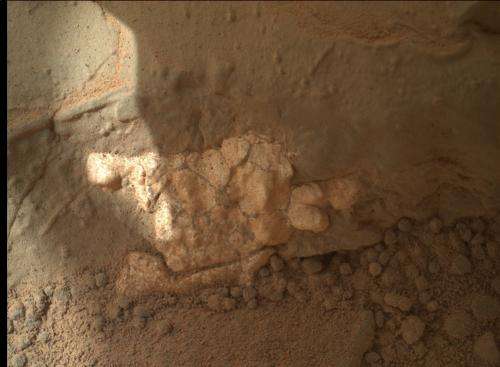About that 'flower' on Mars….

The Curiosity rover is having a "field day" exploring the rocks in shallow depression that scientists call 'Yellowknife Bay', which is chockfull of light toned rocks. One small rock or feature – the size of a pebble or large grain of sand, actually – has caught the attention of many as it looks like a little flower. Keep in mind that this pebble is about 2 millimeters in size (a US dime coin is 1.35mm thick) so that's really teeny tiny. But through the power of zooming in to the high resolution images of the Mars Hand Lens Imager, or MAHLI, there have been people who are convinced this is some sort of flora on Mars, or perhaps a fossil.
Initially, it was suggested that this could perhaps be a piece of plastic from the rover, similar to what was found earlier, but the MSL scientists quickly determined this was actually part of the rock.
Today, deputy principal investigator of MAHLI, Aileen Yingst of the Planetary Science Institute, told reporters that the big rock of which the flower is a part, named 'Gillespie Lake,' is a relatively dust free, coarse grained sandstone, with several larger grains in the matrix, "which are interesting because of their color, luster and shape," she said, and this unusually shaped grain is lighter in color – almost opaque—which indicates it could be made of something different than the rest of the rock.
What is it?
"It could be a lot of things, but without some chemical information to back me up, I'd really hesitate to say what it is," said Yingst. "I'm not trying to be cagey, I'm just trying to be clear that a light grain could be a lot of different things."
But what really matters is what the team is finding out about this region, as those rounded grains provide a clue to the history of this area.
"They've been knocked around, they've been busted up," said Yingst. "They've been rounded by some process.
This suggests that flowing water helped form this rock.
Yingst also stressed that is feature is not biological, "But it does indicate that you have a relatively diverse set of grains just in this one sample," she said.
So, water in the past but no flowers on Mars.
The rover has also found water-deposited mineral veins that fill fissures in the rocks, such as in the image below.
The team will continue to study this area, and have chosen a rock on which to use the rover's drill for the first time.

Source: Universe Today





















